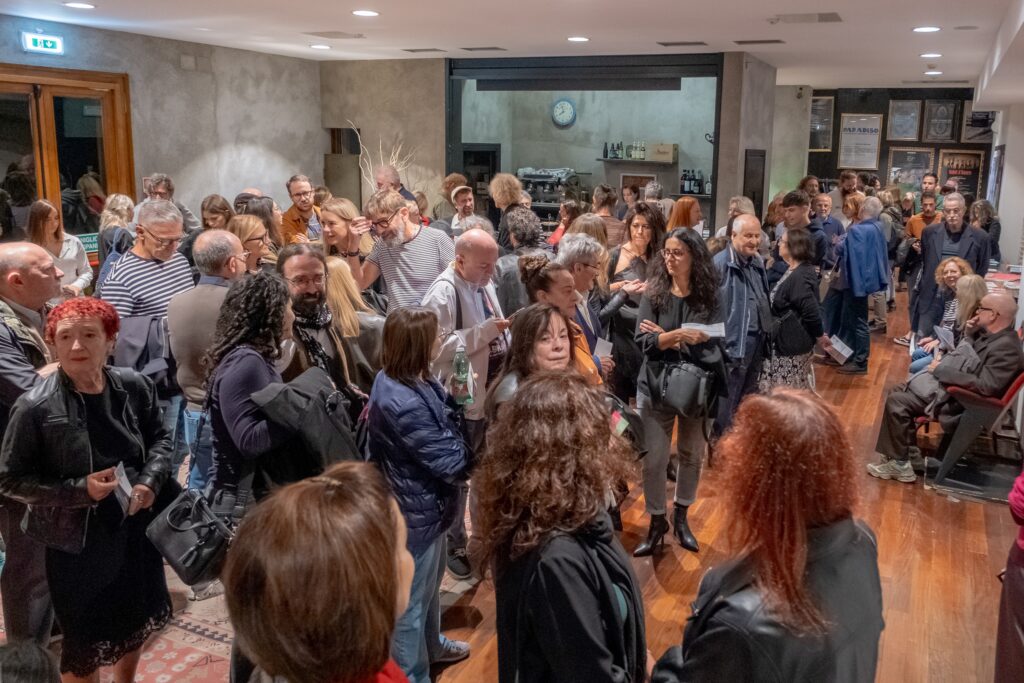Here is the final video of the third and last part of POLIS 2025, which covers the celebrations for ErosAntEros’ 15th anniversary.
Thank you all!
Enjoy!
Video by Les Bompart
CONVERSATION WITH AGATA TOMŠIČ AND DAVIDE SACCO. ErosAntEros: fifteen years of love versus love
Nicola Arrigoni, “Sipario”, October 18th 2025
https://www.sipario.it/attualita/i-fatti/item/17003-conversazione-con-agata-tomsic-e-davide-sacco-erosanteros-quindici-anni-di-amore-contro-amore-di-nicola-arrigoni.html
ErosAntEros celebrates its 15th anniversary with two experimental works
Marco De Marinis, “Il Fatto Quotidiano”, October 13th 2025
https://www.ilfattoquotidiano.it/2025/10/13/erosanteros-teatro-sperimentale-ravenna-news/8151008/
The final part of POLIS Teatro Festival in Ravenna has just ended, with much applause and involvement from the public, operators, and journalists from all over Europe. The festival celebrated the 15th anniversary of the ErosAntEros company with an extraordinary event: the preview of its two new works, Medea Material by Agata Tomšič, from Heiner Müller, and The Ones Who Walk Away from Omelas by Davide Sacco, based on Ursula K. Le Guin.
With this special event the company celebrated 3 important anniversaries: 15 years of ErosAntEros, 30 years since the death of Heiner Müller, and 50 years since the publication of The Ones Who Walk Away from Omelas by Ursula K. Le Guin. A rich program, brought to international attention through a new collaboration with ATER Fondazione, accompanied by several side events such as: an international panel on Heiner Müller and a round table to celebrate the anniversary of the founding of ErosAntEros.
A project by ErosAntEros and POLIS Teatro Festival, supported by Ministero della Cultura, Regione Emilia-Romagna, Comune di Ravenna and made possibile thanks to precious collaborations: with Dipartimento di Interpretazione e Traduzione dell’UniBo (in Forlì) for the creation of English surtitles that made the performances accessible to international operators; cwith Goethe-Institut Mailand and ACIT – Ass. Cult. Italo-Tedesca.
Thanks!
Here some photos by Dario Bonazza.
15 YEARS OF EROSANTEROS
Friday, September 26th 2025






Saturday, September 27th 2025






ErosAntEros celebrates its 15 years…
Chantal Boiron, “UBU Scènes d’Europe / European Stages”, October 6th 2025
https://ubu-apite.org/erosanteros-fete-ses-quinze-ans/
ErosAntEros’ interview for the 15 years of the company.
Live on Radio3Suite – Panorama, curated by Marco Cosci, on September 25th 2025.
PODCAST (from 7′)
Davide Sacco / ErosAntEros’ interview for the 15 years of the company.
Live on Radio Città Fujiko, curated by William Piana, on September 26th 2025.
«Our passion for theater spans 15 years. Here, you can practice making a revolution»
Alessandro Fogli, “Ravenna&Dintorni”, September 26th 2025
https://www.ravennaedintorni.it/cultura/2025/09/26/erosanteros-intervita-15-anni/
ErosAntEros – POLIS Teatro Festival enters again the national network L’Italia dei Visionari, a project promoted jointly by: CapoTrave / Kilowatt (Sansepolcro AR), Festival Le Città Visibili (Rimini), Progetto Fertili Terreni Teatro* (Torino), Pilar Ternera/NTC (Livorno) and Ass. Cult. Madame Rebinè / Ricò (San Quirino PN).
Every year a call is launched for individual artists and emerging and independent companies that operate professionally in contemporary theater, dance and performing arts.
There is time until November 12th 2025 (12 p.m.).
ErosAntEros – POLIS Teatro Festival joins again the national network of theaters, festivals and institutions of In-Box, which selects and promotes some of the most interesting productive experiences of the Italian emerging scene.
A total of more than 80 partners spread across 15 regions in Italy make up the In-Box network,
The In-Box call 2025-26 is online and is open to emerging artists, artists and companies of all ages. No later than noon on October 8th, 2025, interested subjects must complete the online application process. At stake is a maximum of 93 performances, including a date at POLIS Teatro Festival 2027!
All the info: https://www.inboxproject.it/
Utopia and autonomy. Polis Teatro Festival in Ravenna
Sergio Lo Gatto, “teatroecritica”, June 8th 2025
https://www.teatroecritica.net/2025/06/utopia-e-autonomia-polis-teatro-festival-ravenna-2025/
What human beings are really capable of
Eleonora Poli, “Ateatro”, June 5th 2025
https://www.ateatro.it/2025/06/05/di-cosa-e-davvero-capace-lessere-umano/
Some review and a press conference
Silvia Napoli, “il manifesto”, May 26th 2025
https://www.ilmanifestoinrete.it/2025/05/26/qualche-recensione-e-una-conferenza-stampa/
POLIS Teatro Festival 2025 came to an end, overcoming a double challenge. On the occasion of its eighth edition, it put two big surprises at the center: POLIS NEON, the under35 section of the festival, and the IBERIAN FOCUS with international guests.
Thank you to all the people who have been with us and supported us!
Here some photos by Dario Bonazza
POLIS NEON
Friday May 2nd 2025






Saturday May 3rd 2025






IBERIAN FOCUS
Tuesday My 6th 2025






Wednesday May 7th 2025



Thursday May 8th 2025






Friday May 9th 2025






Saturday May 10th 2025









Sunday May 11th 2025






Polis teatro festival 2025
Maria Dolores Pesce, “dramma.it”, May 19th 2025
https://www.dramma.it/index.php?option=com_content&view=article&id=39264:polis-teatro-festival-2025&catid=40&Itemid=12
Traumas, utopias and desires: the new Iberian scene at Polis Teatro Festival
Olindo Rampin, “PAC – Paneacquaculture”, May 18th 2025
https://www.paneacquaculture.net/2025/05/18/traumi-utopie-e-desideri-la-nuova-scena-iberica-al-polis-teatro-festival/
Dictatorships, colonialism and the regenerative force of the Polis
Anna Cavallo, “Theatron 2.0”, May 13th 2025
https://webzine.theatronduepuntozero.it/dittature-colonialismo-e-forza-rigeneratrice-della-polis/
Polis festival 25: scene, body and technology between youth and apocalypse
Renzo Francabandera, “PAC”, May 10th 2025
https://www.paneacquaculture.net/2025/05/10/polis-festival-25-scena-corpi-e-tecnologie-tra-gioventu-e-apocalisse/